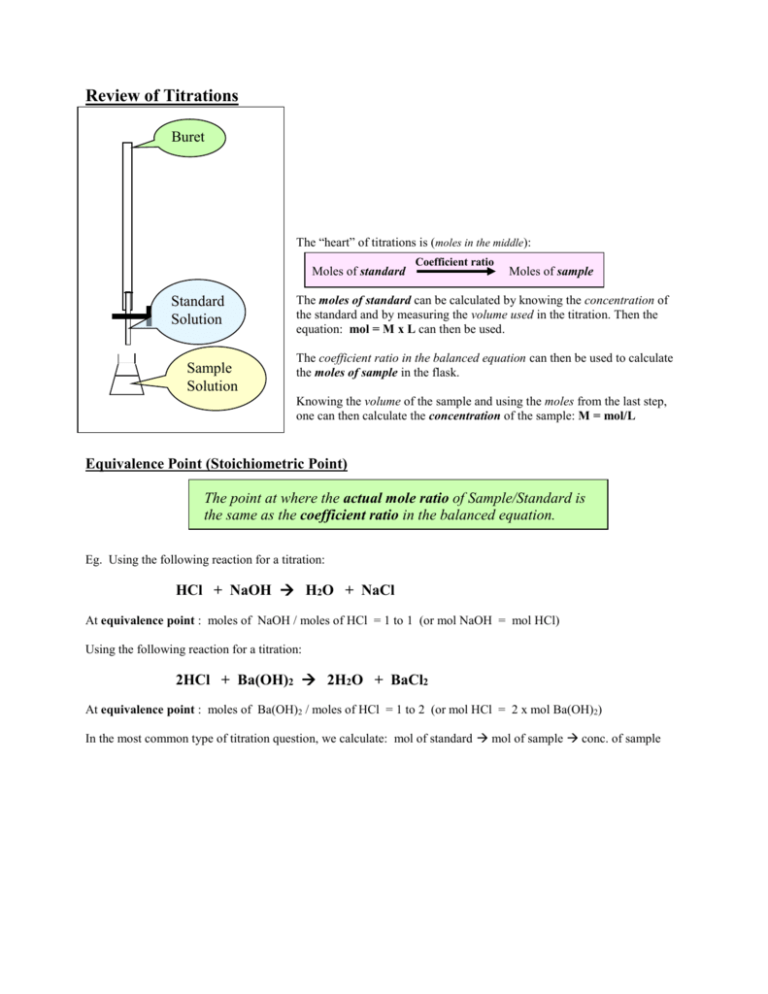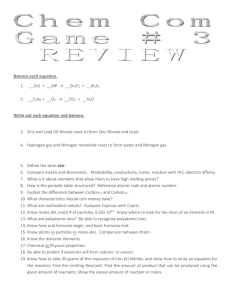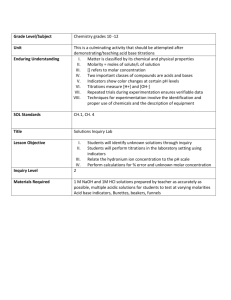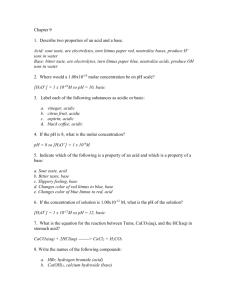Review of Titrations
advertisement

Review of Titrations Buret te The “heart” of titrations is (moles in the middle): Moles of standard Standard Solution Sample Solution Coefficient ratio Moles of sample The moles of standard can be calculated by knowing the concentration of the standard and by measuring the volume used in the titration. Then the equation: mol = M x L can then be used. The coefficient ratio in the balanced equation can then be used to calculate the moles of sample in the flask. Knowing the volume of the sample and using the moles from the last step, one can then calculate the concentration of the sample: M = mol/L Equivalence Point (Stoichiometric Point) The point at where the actual mole ratio of Sample/Standard is the same as the coefficient ratio in the balanced equation. Eg. Using the following reaction for a titration: HCl + NaOH H2O + NaCl At equivalence point : moles of NaOH / moles of HCl = 1 to 1 (or mol NaOH = mol HCl) Using the following reaction for a titration: 2HCl + Ba(OH)2 2H2O + BaCl2 At equivalence point : moles of Ba(OH)2 / moles of HCl = 1 to 2 (or mol HCl = 2 x mol Ba(OH)2) In the most common type of titration question, we calculate: mol of standard mol of sample conc. of sample Here’s an example: A solution of HCl of unknown concentration was titrated with 0.150 M Ba(OH) 2. The equivalence point is reached when 14.83 mL of Ba(OH)2 is added to 50.00 mL of the HCl solution. Find the [HCl] in the original sample. (The standard solution is the one of known concentration in this case the 0.150 M Ba(OH)2 .) 1. Moles of Ba(OH)2 = 0.150 M x 0.01483 L = 0.0022245 mol Ba(OH) 2 2. Moles of HCl: Using the balanced equation: 0.0022245 mol Ba(OH)2 x 2HCl + Ba(OH)2 2H2O + BaCl2 2 mol HCl = 0.004449 mol HCl 1 mol Ba(OH)2 3. [HCl] = 0.004449 mol HCl = 0.0890 M 0.05000 L HCl From the 50.00 mL of the original HCl solution. Don’t forget, if a series of volume readings for different “Trials” are given, you may have to discard a reading that is more than 0.02 or so mL different from the rest of them. This ability to discard “far off” volume readings and then to calculate the “best average” volume will be tested! Also markers always seem to use titration questions to test your ability to handle Significant Digits. Remember, when subtracting (or adding) use decimal places and when multiplying or dividing, use # of SD’s! Here’s a question for you to try: 0.200 M NaOH is used to titrated 3 separate 50.0 mL samples of a solution of H 2SO4 of unknown concentration. The NaOH is in the burette. Use the following data table to calculate the [H 2SO4] in the original H2SO4 solution. Show all of your steps clearly, including the balanced formula equation for the reaction. Initial Burette Reading (mL) Final Burette Reading (mL) Trial 1 0.00 9.02 Trial 2 9.02 17.95 Trial 3 17.95 26.89 Read “Experimental Note” on the bottom of page 157 of SW. Do Ex. 94 – 97 on p. 158 of SW. NOTE: If you check your answers on p. 291 of SW, you’ll notice, he uses “mmol’s” (millimoles) in his work. See p. 154 – 155 of doing these using mmols. You don’t have to use mmols. You can if you like. Just be careful with your units.







